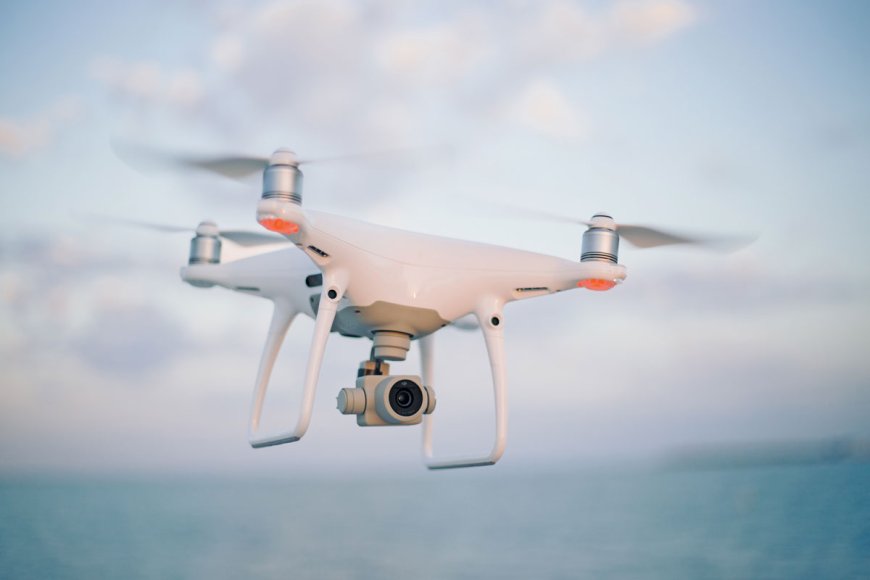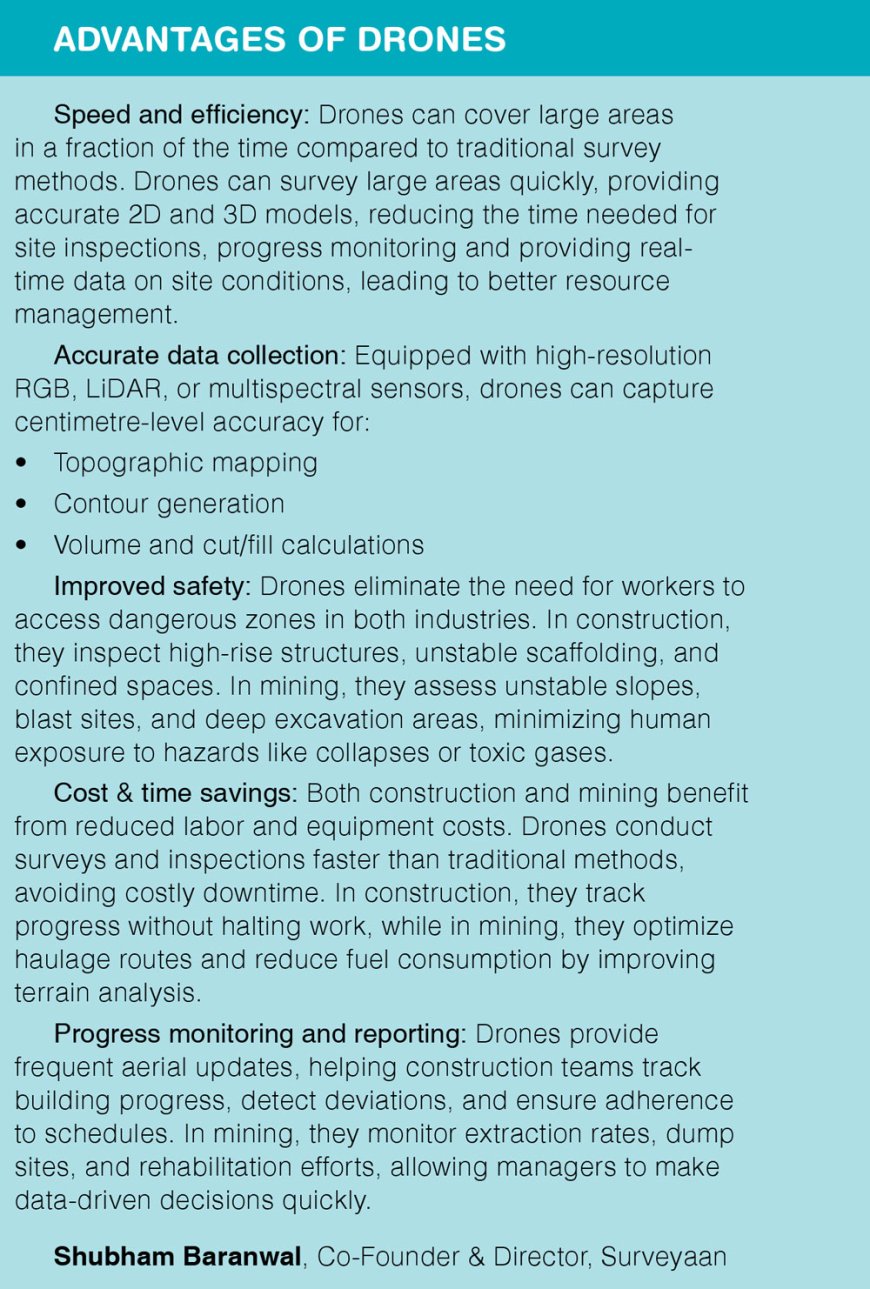Bringing in efficiency and accuracy in projects
Use of drone technology has revolutionized the construction and mining projects in the country with high precision monitoring and control. Construction Times presents the evolution and the way forward.

Use of drone technology has revolutionized the construction and mining projects in the country with high precision monitoring and control. Construction Times presents the evolution and the way forward.
Use of drones has brought in a new revolution in the construction industry. In construction projects, drones are used in all phases, from preliminary site assessments to final inspections. They are used in variety of tasks, which improves accuracy, lowers complexity, and produces data required for effective project management. Drones help improve construction workflow by increasing accuracy, efficiency and data handling throughout different phases of a project. They have rapidly advanced into a critical component of digital infrastructure management. With advancements in hardware, sensors like LiDAR and high-resolution RGB cameras, and the introduction of automated flight planning tools, drones quickly became powerful assets for topographic surveys, volumetric analysis, and real-time progress monitoring.
Advantages
 Drones are used in construction projects at various phases, for initial site assessment, design and planning, construction and project management, quality control and post-construction surveillance. Drones have accelerated timelines, improved accuracy, and brought a new layer of accountability to large-scale construction projects. Drones are redefining the pace and precision of development. Vipul Bhati, Co-founder, Aakashe, says, “In construction, drones offer instant situational awareness, project-wide visibility, and accurate geospatial data that helps reduce human error and rework. At Aakashe, our ready-to-use drone imagery provides decision-makers with instant access to high quality drone imagery; be it for land use planning, utility alignment, progress tracking, or compliance monitoring. This reduces delays, enhances transparency, and supports faster, informed decisions across stakeholders.”
Drones are used in construction projects at various phases, for initial site assessment, design and planning, construction and project management, quality control and post-construction surveillance. Drones have accelerated timelines, improved accuracy, and brought a new layer of accountability to large-scale construction projects. Drones are redefining the pace and precision of development. Vipul Bhati, Co-founder, Aakashe, says, “In construction, drones offer instant situational awareness, project-wide visibility, and accurate geospatial data that helps reduce human error and rework. At Aakashe, our ready-to-use drone imagery provides decision-makers with instant access to high quality drone imagery; be it for land use planning, utility alignment, progress tracking, or compliance monitoring. This reduces delays, enhances transparency, and supports faster, informed decisions across stakeholders.”
 Sujit Mule, Managing Director, Rachana Construction Ltd, adds, “Integrating drone technology has not only improved our operational efficiency but also elevated the quality and safety standards of our highway projects. It’s a testament to how embracing innovation can lead to tangible improvements in infrastructure development.”
Sujit Mule, Managing Director, Rachana Construction Ltd, adds, “Integrating drone technology has not only improved our operational efficiency but also elevated the quality and safety standards of our highway projects. It’s a testament to how embracing innovation can lead to tangible improvements in infrastructure development.”
Current application trends
There is a sharp increase in the use of drones in various construction projects in the recent past. Bhati says, “We have witnessed a sharp rise in drone usage for urban infrastructure planning, land administration, road and railway corridor mapping, utility mapping, and city profiling. We’re seeing growing adoption in smart city missions, greenfield developments, and large-scale government initiatives like PM Gati Shakti.”
 Shubham Baranwal, Co-Founder & Director, Surveyaan, adds, “In 2024, India has witnessed a significant surge in drone applications across construction and mining sectors, driven by technological advancements, supportive government policies, and increasing demand for efficiency and safety.”
Shubham Baranwal, Co-Founder & Director, Surveyaan, adds, “In 2024, India has witnessed a significant surge in drone applications across construction and mining sectors, driven by technological advancements, supportive government policies, and increasing demand for efficiency and safety.”
Mule says, “At Rachana Construction Ltd, drones have become an integral part of our highway and roadway projects. Before construction begins, drone-based topographical surveys provide us with precise terrain data, enabling accurate planning and design. This early insight helps in identifying potential challenges and optimizing route alignments.”
Technology innovation to drive future
The drone industry is rapidly evolving to transform construction and mining operations through technological innovation and regulatory advancements. Baranwal highlights, “Artificial intelligence and autonomous operations will become central to drone capabilities. Future systems will feature fully automated drones with advanced AI-powered obstacle avoidance for real-time site monitoring. These intelligent drones will incorporate predictive analytics to forecast potential equipment failures, slope instability risks, and project delays before they occur.”
Mule elaborates on how drones are helping to bring in efficiency and accuracy in their projects, “During construction, regular drone flights offer real-time monitoring of progress across extensive stretches of road. This continuous oversight allows us to detect and address issues promptly, ensuring that projects stay on schedule. Drones also enhance safety by inspecting hard-to-reach areas, reducing the need for manual checks in hazardous zones.”
He further adds, “Post-construction, drones assist in quality assurance by capturing high-resolution imagery for detailed analysis. This ensures that the finished infrastructure meets our stringent standards and provides a reliable assessment for maintenance planning.”
Going ahead, the market trend looks positive for using drones in construction and mining project applications. With the proper awareness about the technology and its advantages, coupled with government policy support, drone services will push the growth of construction and mining sectors in the years ahead.

Advantages of drones
Speed and efficiency: Drones can cover large areas in a fraction of the time compared to traditional survey methods. Drones can survey large areas quickly, providing accurate 2D and 3D models, reducing the time needed for site inspections, progress monitoring and providing real-time data on site conditions, leading to better resource management.
Accurate data collection: Equipped with high-resolution RGB, LiDAR, or multispectral sensors, drones can capture centimetre-level accuracy for:
• Topographic mapping
• Contour generation
• Volume and cut/fill calculations
Improved safety: Drones eliminate the need for workers to access dangerous zones in both industries. In construction, they inspect high-rise structures, unstable scaffolding, and confined spaces. In mining, they assess unstable slopes, blast sites, and deep excavation areas, minimizing human exposure to hazards like collapses or toxic gases.
Cost & time savings: Both construction and mining benefit from reduced labor and equipment costs. Drones conduct surveys and inspections faster than traditional methods, avoiding costly downtime. In construction, they track progress without halting work, while in mining, they optimize haulage routes and reduce fuel consumption by improving terrain analysis.
Progress monitoring and reporting: Drones provide frequent aerial updates, helping construction teams track building progress, detect deviations, and ensure adherence to schedules. In mining, they monitor extraction rates, dump sites, and rehabilitation efforts, allowing managers to make data-driven decisions quickly.
Shubham Baranwal, Co-Founder & Director, Surveyaan
 Steps to promote drone applications
Steps to promote drone applications
Educate and create awareness: Conduct workshops, seminars, and demo days at construction sites, mining zones, and industry expos publishing detailed case studies will help build confidence in drone technology among traditional industry players.
Train and upskill the workforce: Creating a skilled workforce is crucial for sustainable adoption. This involves establishing certified training programs through partnerships with institutes to produce qualified drone pilots. Beyond flight operations, engineers need training in specialized data processing tools to derive maximum value from drone-captured data. Integration of drone training into government skilling initiatives would ensure wider accessibility and standardization of skills across the workforce.
Technology integration: For maximum impact, drone technology must seamlessly integrate with existing systems. Ensuring compatibility with BIM platforms, GIS systems and AutoCAD will make drone data more actionable. Advanced applications like AI-powered analytics can transform raw data into real-time operational insights (e.g., automated stockpile volume calculations).
Industry collaboration: To accelerate the adoption of drones in India's construction and mining sectors, strategic industry collaboration is essential. Leading government entities should mandate drone-based monitoring in tenders for critical applications such as stockpile audits, progress tracking, and environmental compliance solutions.
Government advocacy: Policy leadership can drive rapid adoption. Making drone-based monitoring mandatory for EIA compliance in mining would create immediate demand. Aligning drone data collection with national initiatives would demonstrate how drone technology supports larger infrastructure development goals while creating standardized datasets for planning and monitoring purposes.







